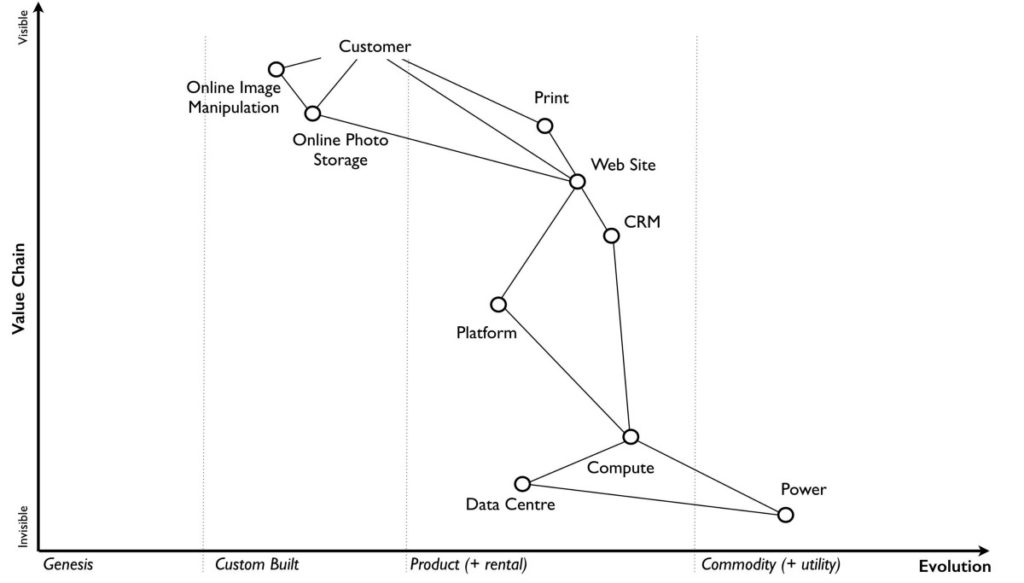Archive for the ‘How To’ Category
Choosing What To Do
 In business you’ve got to do two things: choose what to do and choose how to do it well. I’m not sure which is more important, but I am sure there’s far more written on how to do things well and far less clarity around how to choose what to do.
In business you’ve got to do two things: choose what to do and choose how to do it well. I’m not sure which is more important, but I am sure there’s far more written on how to do things well and far less clarity around how to choose what to do.
Choosing what to do starts with understanding what’s being done now. For technology, it’s defining the state-of-the-art. For the business model, it’s how the leading companies are interacting with customers and which functions they are outsourcing and which they are doing themselves. In neither case does what’s being done define your new recipe, but in both cases it’s the first step to figuring how you’ll differentiate over the competition.
Every observation of the state-of-the-art technologies and latest business models is a snapshot in time. You know what’s happening at this instant, but you don’t know what things will look like in two years when you launch. And that’s not good enough. You’ve got to know the improvement trajectories; you’ve got to know if those trajectories will still hold true when you’ll launch your offering; and, if they’re out of gas, you’ve got to figure out the new improvement areas and their trajectories.
You’ve got to differentiate over the in-the-future competition who will constantly improve over the next two years, not the in-the-moment competition you see today.
For technology, first look at the competitions’ websites. For their latest product or service, figure out what they’re proud of, what they brag about, what line of goodness it offers. For example, is it faster, smaller, lighter, more powerful or less expensive? Then, look at the product it replaced and what it offered. If the old was faster than the one it replaced and the newest one was faster still, their next one will try to be faster. But if the old one was faster than the one it replaced and the newest one is proud of something else, it’s likely they’ll try to give the next one more of that same something else.
And the rate of improvement gives another clue. If the improvement is decreasing over time (old product to new product), it’s likely the next one will improve on a new line of goodness. If it’s still accelerating, expect more of what they did last time. Use the slope to estimate the magnitude of improvement two years from now. That’s what you’ve got to be better than.
And with business models, make a Wardley Map. On the map, place the elements of the business ecosystem (I hate that word) and connect the elements that interact with each other. And now the tricky part. Move to the right the mature elements (e.g., electrical power grid), move to the middle the immature elements (things that are clunky and you have to make yourself) and move to the middle the parts you can buy from others (products). There’s a north-south element to the maps, but that’s for another time.
The business model is defined by which elements the company does itself, which it buys from others and which new ones they create in their labs. So, make a model for each competitor. You’ll be able to see their business model visually.
Now, which elements to work on? Buy the ones you can buy (middle), improve the immature ones on the far left so they move toward the central region (product) and disrupt the lazy utilities (on the right) with some crazy technology development and create something new on the far left (get something running in the lab).
Choosing what to work on starts with Observation of what’s going on now. Then, that information is Oriented with analysis, synthesis and diverse perspective. Then, using the best frameworks you know, a Decision is made. And then, and only then, can you Act.
And there you have it. The makings of an OODA loop-based methodology for choosing what to do.
For a great podcast on John Boyd, the father of the OODA loop, try this one.
And for the deepest dive on OODA (don’t start with this one) see Osinga – Science, Strategy and War.
Validate the Business Model Before Building It.
 One of the best ways to learn is to make a prototype. Prototypes come in many shapes and sizes, but their defining element is the learning objective behind them. When you start with what you want to learn, the prototype is sure to satisfy the learning objective. But start with the prototype, and no one is quite sure what you’ll learn. When prototypes come before the learning objective, prototypes are inefficient and ineffective.
One of the best ways to learn is to make a prototype. Prototypes come in many shapes and sizes, but their defining element is the learning objective behind them. When you start with what you want to learn, the prototype is sure to satisfy the learning objective. But start with the prototype, and no one is quite sure what you’ll learn. When prototypes come before the learning objective, prototypes are inefficient and ineffective.
Before staffing a big project, prototypes can be used to determine viability of the project. And done right, viability prototypes can make for fast and effective learning. Usually, the team wants to build a functional prototype of the product or service, but that’s money poorly spent until the business model is validated. There’s nothing worse than building expensive prototypes and staffing a project, only to find the business model doesn’t hold water and no one buys the new thing you’re selling.
There’s no reason a business model can’t be validated with a simple prototype. (Think one-page sales tool.) And there’s no reason it can’t be done at the earliest stages. More strongly, the detailed work should be held hostage until the business model is validated. And when it’s validated, you can feel good about the pot of gold at the end of the rainbow. And if it’s invalidated, you saved a lot of time, money and embarrassment.
The best way to validate the business model is with a set of one-page documents that define for the customer what you will sell them, how you’ll sell it, how you’ll service it, how you’ll train them and how you’ll support them over the life of your offering. And, don’t forget to tell them how much it will cost.
The worst way to validate the business model is buy building it. All the learning happens after all the money has been spent.
For the business model prototypes there’s only one learning objective: We want to learn if the customer will buy what we’re selling. For the business model to be viable, the offering has to hang together within the context of installation, service, support, training and price. And the one-page prototype must call out specifics of each element. If you use generalities like “we provide good service” or “our training plans are the best”, you’re faking it.
Don’t let yourself off the hook. Use prototypes to determine the viability of the business model before spending the money to build it.
Image credit – Heather Katsoulis
A Little Uninterrupted Work Goes a Long Way
 If your day doesn’t start with a list of things you want to get done, there’s little chance you’ll get them done. What if you spent thirty minutes to define what you want to get done and then spent an hour getting them done? In ninety minutes you’ll have made a significant dent in the most important work. It doesn’t sound like a big deal, but it’s bigger than big. Question: How often do you work for thirty minutes without interruptions?
If your day doesn’t start with a list of things you want to get done, there’s little chance you’ll get them done. What if you spent thirty minutes to define what you want to get done and then spent an hour getting them done? In ninety minutes you’ll have made a significant dent in the most important work. It doesn’t sound like a big deal, but it’s bigger than big. Question: How often do you work for thirty minutes without interruptions?
Switching costs are high, but we don’t behave that way. Once interrupted, what if it takes ten minutes to get back into the groove? What if it takes fifteen minutes? What if you’re interrupted every ten or fifteen minutes? Question: What if the minimum time block to do real thinking is thirty minutes of uninterrupted time?
Let’s assume for your average week you carve out sixty minutes of uninterrupted time each day to do meaningful work, then, doing as I propose – spending thirty minutes planning and sixty minutes doing something meaningful every day – increases your meaningful work by 50%. Not bad. And if for your average week you currently spend thirty contiguous minutes each day doing deep work, the proposed ninety-minute arrangement increases your meaningful work by 200%. A big deal. And if you only work for thirty minutes three out of five days, the ninety-minute arrangement increases your meaningful work by 400%. A night and day difference.
Question: How many times per week do you spend thirty minutes of uninterrupted time working on the most important things? How would things change if every day you spent thirty minutes planning and sixty minutes doing the most important work?
Great idea, but with today’s business culture there’s no way to block out ninety minutes of uninterrupted time. To that I say, before going to work, plan for thirty minutes at home. And set up a sixty-minute recurring meeting with yourself first thing every morning and do sixty minutes of uninterrupted work. And if you can’t sit at your desk without being interrupted, hold the sixty-minute meeting with yourself in a location where you won’t be interrupted. And, to make up for the thirty minutes you spent planning at home, leave thirty minutes early.
No way. Can’t do it. Won’t work.
It will work. Here’s why. Over the course of a month, you’ll have done at least 50% more real work than everyone else. And, because your work time is uninterrupted, the quality of your work will be better than everyone else’s. And, because you spend time planning, you will work on the most important things. More deep work, higher quality working conditions, and regular planning. You can’t beat that, even if it’s only sixty to ninety minutes per day.
The math works because in our normal working mode, we don’t spend much time working in an uninterrupted way. Do the math for yourself. Sum the number of minutes per week you spend working at least thirty minutes at time. And whatever the number, figure out a way to increase the minutes by 50%. A small number of minutes will make a big difference.
Image credit – NASA Goddard Space Flight Center
Testing the Business Model
 Sometimes we get caught up in the details when we should be working on the foundation. Here’s a rule: If the underlying foundation is not secure, don’t bother working on anything else.
Sometimes we get caught up in the details when we should be working on the foundation. Here’s a rule: If the underlying foundation is not secure, don’t bother working on anything else.
If you’re working on a couple new technologies, but the overall business model won’t be profitable, don’t work on the new technologies. Instead, figure out a business model that is profitable, then do what it takes (technology, simplification, process improvement) to make it happen. But, often, that’s not what we do.
Often, we put the cart before the horse. We create projects to make prototypes that demonstrate a new technology, but the whole business premise is built on quicksand. There’s a reason why foundations are made from concrete and not quicksand. It’s because you can build on top of a base made of concrete. It supports the load. It doesn’t crack, nor does it fall apart. Think Pyramid of Giza.
Because foundations are big and expensive they can be difficult and expensive to test. For example, if an innovation is based on a new foundation, say, a new business model, building a physical prototype of the new business model is too expensive and the testing will not happen. And what usually happens is the foundation goes untested, the higher level technology work is done, the commercialization work is completed and the business model fails because it wasn’t solid.
But you don’t have to build a full-scale prototype of the Pyramid of Giza to test if a pyramid will stand the test of time. You can build a small one and test it, or you can run an analysis of some sort to understand if the pyramid will support the weight. But what if you want to test a new business model, a business model that has never been done before, using new products and services that have never seen the light of day? What do you do? In this case, it doesn’t make sense to make even a scale model. But it does make sense to create a one page sales tool that describes the whole thing and it does make sense to show it to potential customers and ask them what they think about it.
The open question with all new things is – will customers like it enough to buy it. And, it’s no different with the business model. Instead of creating a new website, staffing up, creating new technologies and products, create a one-page sales tool that describes the new elements and show it to potential customers. Distill the value proposition into language people can understand, describe the novelty that fuels the value, capture it on one page, show it to customers, and listen.
And don’t build a single, one-page sales tool, build two or three versions. And then, ask customers what they think. Odds are, they’ll ask you questions you didn’t think they’d ask. Odds are, they’ll see it differently than you do. And, odds are, you’ll have to incorporate their feedback into an improved version of the business model. The bad new is you didn’t get it right. The good news is you didn’t have to staff up and build the whole business model, create the technologies and launch the products. And more good news – you can quickly modify the one-page sales tool and go back to the customers and ask them what they think. And you can do this quickly and inexpensively.
Don’t develop the technology until you know the underlying business model will be profitable. Don’t staff up until you know if the business model holds water. Don’t launch the new products until you verify customers will buy what you want to sell.
Creating a new business model from scratch is an expensive proposition. Don’t build it until you invest in validating it’s worth building.
The worst way to validate a business model is by building it.
Image credit – David Stanley
Make life easy for your customers.
 Companies that have products want to improve them year-on-year. This year’s must be better than last year’s. For selfish reasons, we like to improve cost, speed and quality. Cost reduction drops profit directly to the bottom line. Increased speed reduces overhead (less labor per unit) and increases floor space productivity (more through the factory). Improved quality reduces costs. And for our customers, we like to improve their productivity by helping them do more value-added work with fewer resources. More with less! But there’s a problem – every year it gets more difficult to improve on last year, especially with our narrowly-defined view of what customers value.
Companies that have products want to improve them year-on-year. This year’s must be better than last year’s. For selfish reasons, we like to improve cost, speed and quality. Cost reduction drops profit directly to the bottom line. Increased speed reduces overhead (less labor per unit) and increases floor space productivity (more through the factory). Improved quality reduces costs. And for our customers, we like to improve their productivity by helping them do more value-added work with fewer resources. More with less! But there’s a problem – every year it gets more difficult to improve on last year, especially with our narrowly-defined view of what customers value.
And some companies talk about creating the next generation business model, though no one’s quite sure of what the business model actually is and what makes for a better one.
To break out of our narrow view of “better” and to avoid endless arguments over business models, I suggest an approach based on a simple mantra – Make It Easy.
Make it easy for the customer to _____________.
And take a broad view of what customers actually do. Here are some ideas:
Make it easy to find you. If they can’t find you, they can’t buy from you.
Make it easy to understand what you do and why you do it. Give them a reason to buy.
Make it easy to choose the right solution. No one likes buying the wrong thing.
Make it easy to pay. If they need a loan, why not find one for them?
Make it easy to receive. Think undamaged, recyclable packaging, easy to get off the truck.
Make it easy to install. Don’t think user manuals, think self-installation.
Make it easy to verify it’s ready to go. No screens, no menus. One green light.
Make it easy to deliver the value-added benefit. We over-focus here and can benefit by thinking more broadly. Make it easy to set up, easy to verify the setup, easy to know how to use it, easy change over to the next job.
Make it easy to know the utilization. The product knows when it’s being used, why not give it the authority to automatically tell people how much free time it has?
Make it easy to maintain. When the fastest machine in the world is down for the count, it becomes tied for the slowest machine in the world. Make it easy to know what needs be replaced and when, make it easy to know how to replace it, make it easy to order the replacement parts, make it easy to verify the work was done correctly, make it easy to notify that the work was done correctly, and make it easy to reset the timers.
Make it easy to troubleshoot. Even the best maintenance programs don’t eliminate all the problems. Think auto-diagnosis. Then, like with maintenance, all the follow-on work should be easy.
Make it easy to improve. As the product is used, it learns. It recognizes who is using it, remembers how they like it to behave, then assumes the desired persona.
Though this list is not exhaustive, it provides some food for thought. Yes, most of the list is not traditionally considered value-added activities. But, customers DO value improvements in these areas because these are the jobs they must do. If your competition is focused narrowly on productivity, why not differentiate by making it easy in a more broader sense? When you do, they’ll buy more.
And don’t argue about your business model. Instead, choose important jobs to be done and make them easier for the customer. In that way, how you prioritize your work defines your business model. Think of the business model as a result.
And for a deeper dive on how to make it easy, here’s one of my favorite posts. The takeaway – Don’t push people toward an objective. Instead, eliminate what’s in the way.
Image credit – Hernán Piñera
The Slow No
 When there’s too much to do and too few to do it, the natural state of the system is fuller than full. And in today’s world we run all our systems this way, including our people systems.
When there’s too much to do and too few to do it, the natural state of the system is fuller than full. And in today’s world we run all our systems this way, including our people systems.
A funny thing happens when people’s plates are full – when a new task is added an existing one hits the floor. This isn’t negligence, it’s not the result of a bad attitude and it’s not about being a team player. This is an inherent property of full plates – they cannot support a new task without another sliding off. And drinking glasses have this same interesting property – when full, adding more water just gets the floor wet.
But for some reason we think people are different. We think we can add tasks without asking about free capacity and still expect the tasks to get done. What’s even more strange – when our people tell us they cannot get the work done because they already have too much, we don’t behave like we believe them. We say things like “Can you do more things in parallel?” and “Projects have natural slow phases, maybe you can do this new project during the slow times.” Let’s be clear with each other – we’re all overloaded, there are no slow times.
For a long time now, we’ve told people we don’t want to hear no. And now, they no longer tell us. They still know they can’t get the work done, but they know not to use the word “no.” And that’s why the Slow No was invented.
The Slow No is when we put a new project on the three year road map knowing full-well we’ll never get to it. It’s not a no right now, it’s a no three years from now. It’s elegant in its simplicity. We’ll put it on the list; we’ll put it in the queue; we’ll put it on the road map. The trick is to follow normal practices to avoid raising concerns or drawing attention. The key to the Slow No is to use our existing planning mechanisms in perfectly acceptable ways.
There’s a big downside to the Slow No – it helps us think we’ve got things under control when we don’t. We see a full hopper of ideas and think our future products will have sizzle. We see a full road map and think we’re going to have a huge competitive advantage over our competitors. In both situations, we feel good and in both situations, we shouldn’t. And that’s the problem. The Slow No helps us see things as we want them and blocks us from seeing them as they are.
The Slow No is bad for business, and we should do everything we can to get rid of it. But, it’s engrained behavior and will be with us for the near future. We need some tools to battle the dark art of the Slow No.
The Slow No gives too much value to projects that are on the list but inactive. We’ve got to elevate the importance of active, fully-staffed projects and devalue all inactive projects. Think – no partial credit. If a project is active and fully-staffed, it gets full credit. If it’s inactive (on a list, in the queue, or on the road map) it gets zero credit. None. As a project, it does not exist.
To see things as they are, make a list of the active, fully-staffed projects. Look at the list and feel what you feel, but these are the only projects that matter. And for the road map, don’t bother with it. Instead, think about how to finish the projects you have. And when you finish one, start a new one.
The most difficult element of the approach is the valuation of active but partially-staffed projects. To break the vice grip of the Slow No, think no partial credit. The project is either fully-staffed or it isn’t And if it’s not fully-staffed, give the project zero value. None. I know this sounds outlandish, but the partially-staffed project is the slippery slope that gives the Slow No its power.
For every fully-staffed project on your list, define the next project you’ll start once the current one is finished. Three active projects, three next projects. That’s it. If you feel the need to create a road map, go for it. Then, for each active project, use the road map to choose the next projects. Again, three active projects, three next projects. And, once the next projects are selected, there’s no need to look at the road map until the next projects are almost complete.
The only projects that truly matter are the ones you are working on.
Image credit – DaPuglet
How to Choose the Best Idea
 We have too many ideas, but too few great ones. We don’t need more ideas, we need a way to choose the best one or two ideas and run them to ground.
We have too many ideas, but too few great ones. We don’t need more ideas, we need a way to choose the best one or two ideas and run them to ground.
Before creating more ideas, make a list of the ones you already have. Put them in two boxes. In Box 1, list the ideas without a video of a functional prototype in action. In Box 2, list the ideas that have a video showing a functional prototype demonstrating the idea in action. For those ideas with a functional prototype and no video, put them in Box 1.
Next, throw away Box 1. If it’s not important enough to make a crude physical prototype and create a simple video, the idea isn’t worth a damn. If someone isn’t willing to carve out the time to make a physical prototype, there’s no emotional energy behind the idea and it should be left to die. And when people complain that it’s unfair to throw away all those good ideas in Box 1, tell them it’s unfair to spend valuable resources talking about ideas that aren’t worthy. And suggest, if they want to have a discussion about an idea, they should build a physical prototype and send you the video. Box 2, or bust.
Next, get the band together and watch the short videos in Box 2, and, as a group, put them in two boxes. In Box 3, put the videos without customers actively using the functional prototype. In Box 4, put the videos with customers actively using the functional prototype.
Next, throw way Box 3. If it’s not important enough to make a trip to an important customer and create a short video, the idea isn’t worth a damn. If you’re not willing to put yourself out there and take the idea to an important customer, the idea is all fizzle and no sizzle. Meaningful ideas take immense personal energy to run through the gauntlet, and without a video of a customer using the functional prototype, there’s not enough energy behind it. And when everyone argues that Box 3 ideas are worth pursuing, tell them to pursue a video showing a most important customer demonstrating the functional prototype.
Next, get the band back together to watch the Box 4 videos. Again, put the videos in two boxes. In Box 5 put the videos where the customer didn’t say what they liked and how they’d use it. In Box 6, put the videos where the customer enthusiastically said what they liked and how they’ll use it.
Next, throw away Box 5. If the customer doesn’t think enough about the prototype to tell you how they’ll use it, it’s because they don’t think much of the idea. And when the group says the customer is wrong or the customer doesn’t understand what the prototype is all about, suggest they create a video where a customer enthusiastically explains how they’d use it.
Next, get the band back in the room and watch the Box 6 videos. Put them in two boxes. In Box 7, put the videos that won’t radically grow the top line. In Box 8, put the videos that will radically grow the top line. Throw away Box 7.
For the videos in Box 8, rank them by the amount of top line growth they will create. Put all the videos back into Box 8, except the video that will create the most top line growth. Do NOT throw away Box 8.
The video in your hand IS your company’s best idea. Immediately charter a project to commercialize the idea. Staff it fully. Add resources until adding resources doesn’t no longer pulls in the launch. Only after the project is fully staffed do you put your hand back into Box 8 to select the next best idea.
Continually evaluate Boxes 1 through 8. Continually throw out the boxes without the right videos. Continually choose the best idea from Box 8. And continually staff the projects fully, or don’t start them.
Image credit – joiseyshowaa
What’s your problem?
 If you don’t have a problem, you’ve got a big problem.
If you don’t have a problem, you’ve got a big problem.
It’s important to know where a problem happens, but also when it happens.
Solutions are 90% defining and the other half is solving.
To solve a problem, you’ve got to understand things as they are.
Before you start solving a new problem, solve the one you have now.
It’s good to solve your problems, but it’s better to solve you customers’ problems.
Opportunities are problems in sheep’s clothing.
There’s nothing worse than solving the wrong problem – all the cost with none of the solution.
When you’re stumped by a problem, make it worse then do the opposite.
With problem definition, error on the side of clarity.
All problems are business problems, unless you care about society’s problems.
Odds are, your problem has been solved by someone else. Your real problem is to find them.
Define your problem as narrowly as possible, but no narrower.
Problems are not a sign of weakness.
Before adding something to solve the problem, try removing something.
If your problem involves more than two things, you have more than one problem.
The problem you think you have is never the problem you actually have.
Problems can be solved before, during or after they happen and the solutions are different.
Start with the biggest problem, otherwise you’re only getting ready to solve the biggest problem.
If you can’t draw a closeup sketch of the problem, you don’t understand it well enough.
If you have an itchy backside and you scratch you head, you still have an itch. And it’s the same with problems.
If innovation is all about problem solving and problem solving is all about problem definition, well, there you have it.
Image credit – peasap
Mapping the Future with Wardley Maps
 How do you know when it’s time to reinvent your product, service or business model? If you add ten units of energy and you get less in return than last time, it’s time to work in new design space. If improvement in customer goodness (e.g., miles per gallon in a car) has slowed or stopped, it’s time to seek a new fuel source. If recent patent filings are trivial enhancements that can be measured only with a large sample sizes and statistical analysis, the party is over.
How do you know when it’s time to reinvent your product, service or business model? If you add ten units of energy and you get less in return than last time, it’s time to work in new design space. If improvement in customer goodness (e.g., miles per gallon in a car) has slowed or stopped, it’s time to seek a new fuel source. If recent patent filings are trivial enhancements that can be measured only with a large sample sizes and statistical analysis, the party is over.
When there’s so many new things to work on, how do you choose the next project? When you’re lost, you look at a map. And when there is no map, you make one. The first bit of work is defined by the holes in the first revision of your map. And once the holes are filled and patched, the next work emerges from the map itself. And, in a self-similar way, the next work continually emerges from the previous work until the project finishes.
But with so much new territory, how do you choose the right new territory to map? You don’t. Before there’s a need to map new territory, you must map the current territory. What you’ll learn is there are immature areas that, when made mature, will deliver new value to customers. And you’ll also learn the mature areas that must be blown up and replaced with infant solutions that will ultimately create the next evolution of your business. And as you run thought experiments on your map – projecting advancements on the various elements – the right new territory will emerge. And here’s a hint – the right new solutions will be enabled by the newly matured elements of the map.
But how do you predict where the right new solutions will emerge? I can’t tell you that. You are the experts, not me. All I can say is, make the maps and you’ll know.
And when I say maps, I mean Wardely Maps – here’s a short video (go to 4:13 for the juicy bits).
Image credit – Simon Wardley
Innovation – Words vs. Actions
 Innovation isn’t a thing in itself. Companies need to meet their growth objectives and innovation is the word experts use to describe the practices and behaviors they think will maximize the likelihood of meeting those growth objectives. Innovation is a catchword phrase that has little to no meaning. Don’t ask about innovation, ask how to meet your business objectives. Don’t ask about best practices, ask how has your company been successful and how to build on that success. Don’t ask how the big companies have done it – you’re not them. And, the behaviors of the successful companies are the same behaviors of the unsuccessful companies. The business books suffer from selection bias. You can’t copy another company’s innovation approach. You’re not them. And your project is different and so is the context.
Innovation isn’t a thing in itself. Companies need to meet their growth objectives and innovation is the word experts use to describe the practices and behaviors they think will maximize the likelihood of meeting those growth objectives. Innovation is a catchword phrase that has little to no meaning. Don’t ask about innovation, ask how to meet your business objectives. Don’t ask about best practices, ask how has your company been successful and how to build on that success. Don’t ask how the big companies have done it – you’re not them. And, the behaviors of the successful companies are the same behaviors of the unsuccessful companies. The business books suffer from selection bias. You can’t copy another company’s innovation approach. You’re not them. And your project is different and so is the context.
With innovation, the biggest waste of emotional energy is quest for (and arguments around) best practices. Because innovation is done in domains of high ambiguity, there can be no best practices. Your project has no similarity with your previous projects or the tightest case studies in the literature. There may be good practice or emergent practice, but there can be no best practice. When there is no uncertainty and no ambiguity, a project can use best practices. But, that’s not innovation. If best practices are a strong tenant of your innovation program, run away.
The front end of the innovation process is all about choosing projects. If you want to be more innovative, choose to work on different projects. It’s that simple. But, make no mistake, the principle may be simple the practice is not. Though there’s no acid test for innovation, here are three rules to get you started. (And if you pass these three tests, you’re on your way.)
- If you’ve done it before, it’s not innovation.
- If you know how it will turn out, it’s not innovation.
- If it doesn’t scare the hell out of you, it’s not innovation.
Once a project is selected, the next cataclysmic waste of time is the construction of a detailed project plan. With a well-defined project, a well-defined project plan is a reasonable request. But, for an innovation project with a high degree of ambiguity, a well-defined project plan is impossible. If your innovation leader demands a detailed project plan, it’s usually because they are used running to well-defined continuous improvement projects. If for your innovation projects you’re asked for a detailed project plan, run away.
With innovation projects, you can define step 1. And step 2? It depends. If step 1 works, modify step 2 based on the learning and try step 2. And if step 1 doesn’t work, reformulate step 1 and try again. Repeat this process until the project is complete. One step at a time until you’re done.
Innovation projects are unpredictable. If your innovation projects require hard completion dates, run away.
Innovation projects are all about learning and they are best defined and managed using Learning Objectives (LOs). Instead of step 1 and step 2, think LO1 and LO2. Though there’s little written about LOs, there’s not much to them. Here’s the taxonomy of a LO: We want to learn if [enter what you want to learn]. Innovation projects are nothing more than a series of interconnected LOs. LO2 may require the completion of LO1 or L1 and LO2 could be done in parallel, but that’s your call. Your project plan can be nothing more than a precedence diagram of the Learning Objectives. There’s no need for a detailed Gantt chart. If you’re asked for a detailed Gantt chart, you guessed it – run away.
The Learning Objective defines what you learn, how you want to learn, who will do the learning and when they want to do it. The best way to track LOs is with an Excel spreadsheet with one tab for each LO. For each LO tab, there’s a table that defines the actions, who will do them, what they’ll measure and when they plan to get the actions done. Since the tasks are tightly defined, it’s possible to define reasonable dates. But, since there can be a precedence to the LOs (LO2 depends on the successful completion of LO1), LO2 can be thought of a sequence of events that start when LO1 is completed. In that way, an innovation project can be defined with a single LO spreadsheet that defines the LOs, the tasks to achieve the LOs, who will do the tasks, how success will be determined and when the work will be done. If you want to learn how to do innovation, learn how to use Learning Objectives.
There are more element of innovation to discuss, for example how to define customer segments, how to identify the most important problems, how to create creative solutions, how to estimate financial value of a project and how to go to market. But, those are for another post.
Until then, why not choose a project that scares you, define a small set of Learning Objectives and get going?
Image credit – JD Hancock
If you want to learn, define a learning objective.
 Innovation is all about learning. And if the objective of innovation is learning, why not start with learning objectives?
Innovation is all about learning. And if the objective of innovation is learning, why not start with learning objectives?
Here’s a recipe for learning: define what you want to learn, figure how you want to learn, define what you’ll measure, work the learning plan, define what you learned and repeat.
With innovation, the learning is usually around what customers/users want, what new things (or processes) must be created to satisfy their needs and how to deliver the useful novelty to them. Seems pretty straightforward, until you realize the three elements interact vigorously. Customers’ wants change after you show them the new things you created. The constraints around how you can deliver the useful novelty (new product or service) limit the novelty you can create. And if the customers don’t like the novelty you can create, well, don’t bother delivering it because they won’t buy it.
And that’s why it’s almost impossible to develop a formal innovation process with a firm sequence of operations. Turns out, in reality the actual process looks more like a fur ball than a flow chart. With incomplete knowledge of the customer, you’ve got to define the target customer, knowing full-well you don’t have it right. And at the same time, and, again, with incomplete knowledge, you’ve got to assume you understand their problems and figure out how to solve them. And at the same time, you’ve got to understand the limitations of the commercialization engine and decide which parts can be reused and which parts must be blown up and replaced with something new. All three explore their domains like the proverbial drunken sailor, bumping into lampposts, tripping over curbs and stumbling over each other. And with each iteration, they become less drunk.
If you create an innovation process that defines all the if-then statements, it’s too complicated to be useful. And, because the if-thens are rearward-looking, they don’t apply the current project because every innovation project is different. (If it’s the same as last time, it’s not innovation.) And if you step up the ladder of abstraction and write the process at a high level, the process steps are vague, poorly-defined and less than useful. What’s a drunken sailor to do?
Define the learning objectives, define the learning plan, define what you’ll measure, execute the learning plan, define what you learned and repeat.
When the objective is learning, start with the learning objectives.
Image credit Jean L.
 Mike Shipulski
Mike Shipulski